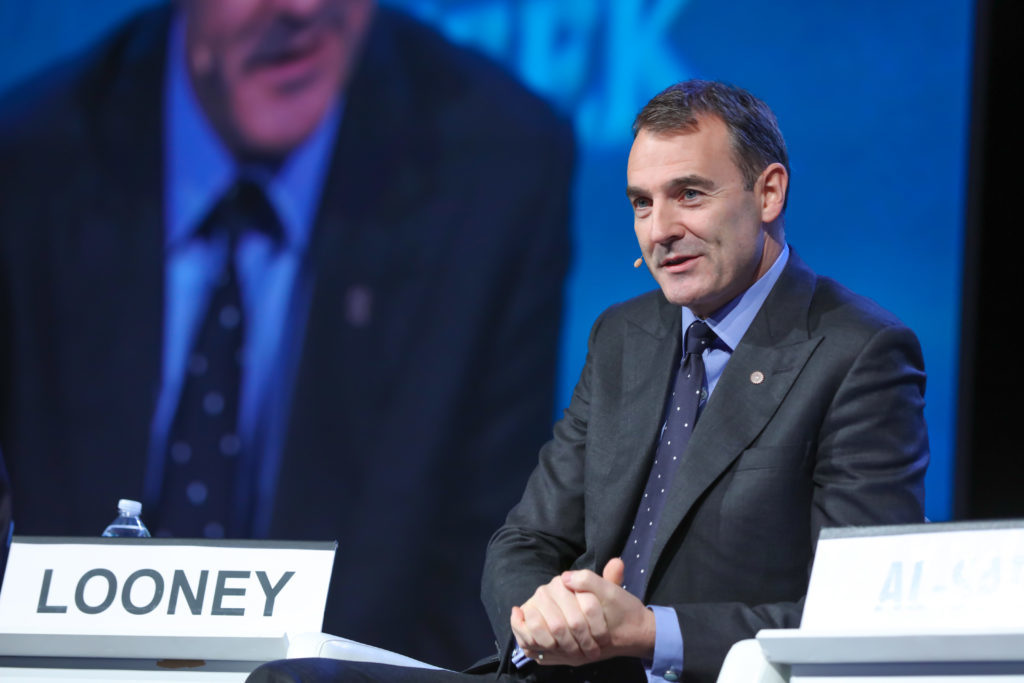
Upstream CEO Bernard Looney spoke about how BP is tackling methane emissions and managing our environmental footprint on a panel discussion during the World Gas Conference. Energy Voice asked him a few questions on the sidelines of the event.
Q. When it comes to emissions, the first inclination is to think of CO2, why is BP focusing on methane?
A. Let me emphasise that we’re fully focussed on curbing greenhouse gas emissions in our operations, both CO2 and methane – and we’ve set targets for both. With methane, there is a particular imperative which is by minimizing emissions you maximise the benefits of gas.
Methane is of course the main component of natural gas, the fastest growing hydrocarbon fuel. As it produces half the carbon emissions of coal when used as a fuel for power generation, natural gas has an important part to play in reducing greenhouse gas emissions.
But methane is also a powerful greenhouse gas, more so than CO2 in the short term. So minimising methane emissions or leaks to the atmosphere from the natural gas chain is important in realising these potential greenhouse gas benefits of natural gas.
As BP grows our gas portfolio, we want to be aggressive in tackling and managing methane emissions from our operations. We are already having significant success in reducing our fugitive methane emissions.
Q. What is BP doing to tackle methane emissions?
A. BP’s approach to advancing a low carbon future involves activities across our business, reducing emissions in our operations, improving our products to help our customers lower theirs and creating new low carbon businesses. Managing methane emissions from our operations is an important part of this.
We have set a challenging target to limit our ‘methane intensity’ to 0.2% and hold it below 0.3%. Methane intensity is methane emissions as a percentage of all the gas that goes to market from the operations where the emissions occur.
To achieve this, we have a lot of activity going on in the upstream, from upgrades in mature, producing fields to new designs and technologies in new ones.
We’re looking across the full spectrum of our operations to identify opportunities to reduce methane emissions.
Q. What examples do you have of effective methane mitigation in the upstream?
A. An important area of focus is our Lower 48 business – BP’s onshore gas production in the United States.
Our Lower 48 team has been doing some amazing things that target early detection and quick intervention. They have been replacing high bleed valves – pneumatic controllers that vent gas – with upgraded versions which emit less methane. Of the 10,000 high bleed valves we had across the business a few years ago, and we will have the last 145 of these devices removed by mid-2019.
We also pioneered a technique there known as ‘green completions’, which captures gas that would otherwise have been flared or vented as wells are completed. And we are increasingly using long horizontal wells rather than multiple vertical ones reducing the potential for leaks by reducing components. Technologies are also playing a role to detect and measure methane emissions and eliminate them wherever possible. Our Lower 48 business has deployed drones to detect methane, and other operations are rolling this out globally. Lower 48 have also been using forward-looking infrared (FLIR) cameras that can detect methane around ground operations.
We’re also looking at methane leak identification and measurement technologies from space using satellites. We see significant opportunities for satellite technology to eventually play an important role in methane detection.
Q. How do you tackle methane in the design of newer projects?
A. In new projects we have been able to ‘design’ out methane emissions from the very beginning. For example, in the giant Khazzan gas field in Oman which will have hundreds of wells, instead of processing gas in multiple clusters of equipment at each well site, the gas is fed by pipe to a central processing facility. This significantly cuts down the number of locations and pieces of equipment where leaks could occur.
Q. Are there any industry efforts to crack down on leaks?
A. Yes, this is an issue for our whole industry and we’re working with partners and peers to develop common approaches and best practice, particularly around detecting and measuring methane emissions.
For example, the Oil & Gas Climate Initiative, of which BP is a founding member, has launched an independent study to measure and compare methane emissions in global gas supply chains. Twelve companies, including BP, have also agreed a set of principles for tackling methane.
Q. Finally, managing emissions of methane is just one component of the gas mix. How do you see the gas narrative developing?
A. Natural gas will be important in meeting the dual challenge the world is now taking on, more energy but lower emissions. The world is now clearly moving down a path towards a low carbon future. But the world is also demanding more energy, helping to lift increasing numbers of the growing population out of low income.
As the cleanest-burning and fastest-growing hydrocarbon fuel, supplies of gas will be essential in meeting that rising energy demand, displacing higher carbon fuels. It can also complement and be integrated with fast-growing renewable energy supplies, helping to address issues such as intermittency.
Gas will play a vital role as the world strives to meet its climate change ambitions and tackling specifics like methane emissions can help us realise its benefits, sooner and more fully.
Recommended for you
